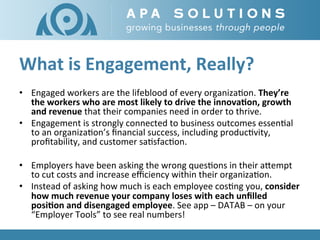CTA - 2015 Talent Trends Recap - preview
- 1. 2015 Talent TrendsTM Presented by: Joan Graci President and Owner Thanks to our sponsor, The Buffalo News!
- 2. Here’s What You Should Know… This is just a preview of our most coveted talent content yet! This HRCI-‐credit-‐approved event has already transformed the way organizaHons approach their human capital strategy for 2015. To get the en<re PDF report, message me :)
- 3. About Joan Joan Graci, President and Owner of APA SoluHons – a direct-‐hire employment and human capital consulHng firm – operates on the philosophy that a company’s greatest asset is its people. In an effort to bridge the gap between employers and employees / job seekers, Joan has made it her personal mission to be an expert mediator. For over 30 years, she has worked side-‐by-‐side with growing organizaHons to help them idenHfy, retain, and develop top talent.
- 4. Presenta<on Topics: • 2014 Talent AcquisiHon Obstacles • The Employer-‐Employee Disconnect • Engaging a MulH-‐GeneraHonal Workforce • Must-‐Know 2015 Talent AcquisiHon Trends • The Future of Talent AcquisiHon
- 5. 2014 TALENT ACQUISITION OBSTACLES TALENT SHORTAGE CULTURAL DIFFERENCES OUTDATED RECRUITING METHODS The driving moHvators for the changing behaviors of HR in 2015
- 6. Talent Shortage: Top 10 Hardest Fields to Fill in 2014 • Skilled trades • Engineers • Technicians • Sales RepresentaHves • Sales Managers • AccounHng / Financial Advisors • Management • IT Engineers and Technical Support • Office Support • Drivers / General Laborors
- 7. The Staggering Outcomes • 54% of employers say this has a direct impact on their customers • 43% say the talent shortage is directly impacHng producHvity and retenHon • 47% of growing companies are adopHng non-‐ tradiHonal human capital strategies • 25% are providing training and development to their exisHng staff • 25% have invested in outside talent sourcing to recruit more untapped talent pools
- 8. The BoTom Line • The most common reason employers struggled to fill jobs is because candidates don’t have the technical competencies required. • Other reasons include a shortage of available applicants, lack of experience or sod skills, and misaligned candidate expectaHons.
- 9. THE EMPLOYER-‐EMPLOYEE DISCONNECT In order to become an “employer of choice,” we must first understand our internal customers (staff members and recruited talent)
- 10. Employees / Job Seekers Think Differently
- 11. Understand What They’re Thinking • There’s a gap within your ranks and each day that posiHon goes unfilled, you’re losing money. • We know that you view each candidate very logically – as a possible soluHon to your problem. But do you know how they feel about the hiring process? NegaHve / Damaged Insecure / Fearful Hesitant / Uncertain
- 12. ENGAGING A MULTI-‐GENERATIONAL WORKFORCE DEFINING YOUR COMPANY CULTURE THE POWER OF ENGAGEMENT GENERATIONAL MOTIVATORS How do you keep your staff happy and producHve?
- 13. Engagement Begins with YOU • Vision – are your employees inspired to come to work everyday? Can they communicate your vision effecHvely? • Leadership – how oden are you looking to improve? – Your employees are the soluHon to change; not the problem • Transparency – are you listening and making feedback part of the employee process (from interviewing, quarterly reviews, and resignaHon) Establish a culture code, which acts as both a promise to your staff and a foundaHon for operaHng
- 14. What is Engagement, Really? • Engaged workers are the lifeblood of every organizaHon. They’re the workers who are most likely to drive the innova<on, growth and revenue that their companies need in order to thrive. • Engagement is strongly connected to business outcomes essenHal to an organizaHon’s financial success, including producHvity, profitability, and customer saHsfacHon. • Employers have been asking the wrong quesHons in their amempt to cut costs and increase efficiency within their organizaHon. • Instead of asking how much is each employee cosHng you, consider how much revenue your company loses with each unfilled posi<on and disengaged employee. See app – DATAB – on your “Employer Tools” to see real numbers!
- 15. Why Engagement MaTers • It is a proven fact that companies with engaged workforces have higher earnings per share and have recovered from the recession at a faster rate. • According to the State of the American Workplace Report, 70% of American workers are “not engaged” or are “ac<vely disengaged.” • From 49 publicly traded companies analyzed, the organizaHons with a criHcal mass of engaged employees outperformed their compeHHon, compared with those that did not maximize their employees’ potenHal. • Companies with an average of 9.3 engaged employees for every acHvely disengaged employee in experienced 147% higher EPS compared with their compeHHon. • Those with an average of 2.6 engaged employees for every acHvely disengaged employee experienced 2% lower EPS compared with their compeHHon during that same Hme period. AcGve disengagement costs the U.S. $450 billion to $550 billion / year
- 16. Engaging Different Genera<ons For the first Hme in history – an era when people are living longer and looking to make their mark on the world sooner – 4 very different genera<ons make up the workforce. In order to engage people of varying ages and backgrounds, it’s important to understand where they’re coming from, what they value, and how they’re stereotyped. • TradiHonalists • Baby Boomers • GeneraHon X • Millennials Because millennials are projected to makeup 75 percent of the workforce in less than a decade, it’s Gme to start understanding what moGvates them at work.
- 17. Top Mo<vators for Workers Today
- 18. Like What You Read? Don’t forget to message me to get the rest of the presentaHon – the full scoop on how today’s top employers are tackling their talent strategies

















